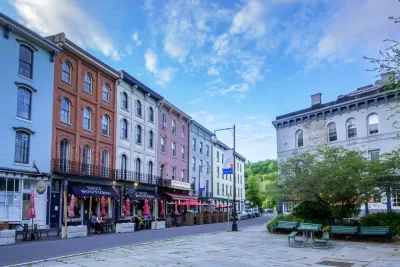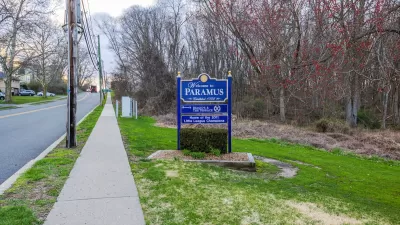Some small cities are proposing zoning code reforms and new taxes to address the growing housing shortage in the greater New York area.

Writing in New York Focus, Sam Mellins examines the housing shortage facing New York suburbs, and how some communities are working to address it.
As Mellins points out, “In the 2010s, New York’s suburbs in the Hudson Valley and on Long Island built three times less housing per capita than the city’s New Jersey suburbs, thanks largely to restrictive zoning regulations.” Now, some are changing how they view growth and acknowledging the growing affordability crisis.
Mellins provides some examples, such as Kingston, which is completely rewriting its zoning code. “Kingston is seeking to enable the creation of new housing stock through a citywide rezoning that will eliminate nearly all single family-only housing zones in the city; abolish parking minimums, which frequently limit space available for housing; and place restrictions on short-term rentals like Airbnbs.” Kingston also passed a rent stabilization ordinance this year which will affect renters in roughly ten percent of its housing units.
In the Hamptons, where permanent residents struggle to find affordable housing, “On November 8, locals will vote on one proposed response: a half-percent tax on high-value home sales. The money would go to a fund reserved for affordable housing projects or financial assistance for first-time homebuyers.”
FULL STORY: Some Suburbs Are Actually Trying to Solve the Housing Shortage

Manufactured Crisis: Losing the Nation’s Largest Source of Unsubsidized Affordable Housing
Manufactured housing communities have long been an affordable housing option for millions of people living in the U.S., but that affordability is disappearing rapidly. How did we get here?

Americans May Be Stuck — But Why?
Americans are moving a lot less than they once did, and that is a problem. While Yoni Applebaum, in his highly-publicized article Stuck, gets the reasons badly wrong, it's still important to ask: why are we moving so much less than before?

Research Shows More Roads = More Driving
A national study shows, once again, that increasing road supply induces additional vehicle travel, particularly over the long run.

Which US Rail Agencies Are Buying Zero-Emissions Trains?
U.S. rail agencies are slowly making the shift to zero-emissions trains, which can travel longer distances without refueling and reduce air pollution.

San Diego School District Approves Affordable Housing Plan
The district plans to build workforce housing for 10 percent of its employees in the next decade and explore other ways to contribute to housing development.

Lawsuit Aims to Stop NYC’s ‘City of Yes’ Zoning Reforms
A lawsuit brought by local lawmakers and community groups claims the plan failed to conduct a comprehensive environmental review.
Urban Design for Planners 1: Software Tools
This six-course series explores essential urban design concepts using open source software and equips planners with the tools they need to participate fully in the urban design process.
Planning for Universal Design
Learn the tools for implementing Universal Design in planning regulations.
City of Moreno Valley
Institute for Housing and Urban Development Studies (IHS)
City of Grandview
Harvard GSD Executive Education
NYU Wagner Graduate School of Public Service
City of Cambridge, Maryland
Newport County Development Council: Connect Greater Newport





























